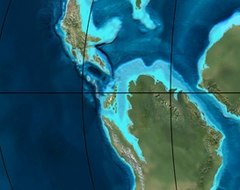| Pacho Formation | |
|---|---|
| Stratigraphic range: Late Albian-Cenomanian ~ | |
| Type | Geological formation |
| Unit of | Villeta Group |
| Underlies | Simijaca Formation |
| Overlies | Hiló Formation |
| Thickness | ~1,050 m (3,440 ft) |
| Lithology | |
| Primary | Siltstone |
| Other | Shale |
| Location | |
| Coordinates | 4°27′07″N74°03′20″W / 4.45194°N 74.05556°W |
| Region | Altiplano Cundiboyacense Eastern Ranges, Andes |
| Country | |
| Type section | |
| Named for | Pacho |
| Named by | Ulloa |
| Location | Pacho |
| Year defined | 1982 |
| Coordinates | 4°27′07″N74°03′20″W / 4.45194°N 74.05556°W |
| Region | Cundinamarca |
| Country | |
 Paleogeography of Northern South America 105 Ma, by Ron Blakey | |
The Pacho Formation (Spanish : Limolitas de Pacho, Kslp) is a geological formation of the Altiplano Cundiboyacense, Eastern Ranges of the Colombian Andes. The formation consisting of alternating siltstones and shales with siderite concretions dates to the Middle Cretaceous period; Late Albian to Cenomanian epochs and has an approximate thickness of 1,050 metres (3,440 ft).





